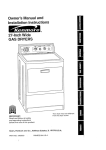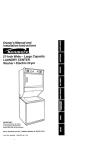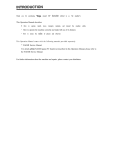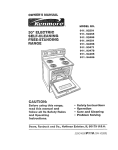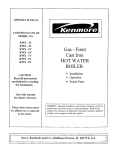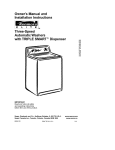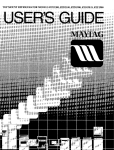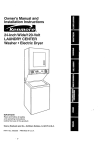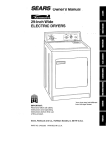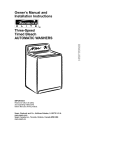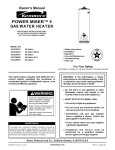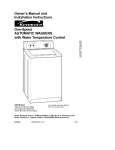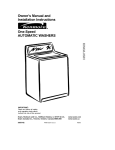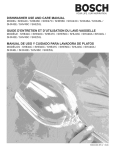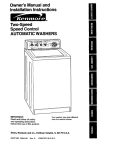Download Kenmore 3405594 Washer/Dryer User Manual
Transcript
Owner's Manual and Installation Instructions 24-Inch Wide LAUNDRY CENTER Washer • Gas Dryer IMPORTANT: Read and follow all safety and operating instructions before first use of this product. Sears, Roebuck and Co., Hoffman Estates, IL 60179 U.S.A. PART NO. 3405594 PRINTED IN U.S.A. WARNING: For your safety the information in this manual must be followed to minimize the risk of fire or explosion or to prevent property damage, personal injury, or death. • Do not store or use gasoline or other flammable vapors and liquids in the vicinity of this or any other appliance. WHAT TO DO IF YOU SMELL GAS • Do not try to light any appliance. • Do not touch any electrical switch; do not use any phone in your building. • Clear the room, building, or area of all occupants. • Immediately call your gas supplier from a neighbor's phone. Follow the gas supplier's instructions. • If you cannot reach your gas supplier, call the fire department. Installation and service must be performed by a qualified installer, service agency, or the gas supplier. BEFORE USING YOUR NEW LAUNDRY CENTER 3 SEARS LAUNDRY CENTER WARRANTY 4 IMPORTANT SAFETY INSTRUCTIONS 5 INSTALLATION 6 INSTRUCTIONS OPERATING INSTRUCTIONS - WASHER 34 OPERATING INSTRUCTIONS - DRYER 40 LAUNDRY TIPS 44 REMOVING STAINS 47 CARING FOR YOUR LAUNDRY CENTER 5O TROUBLESHOOTING - WASHER 54 TROUBLESHOOTING - DRYER 58 SEARS MAINTENANCE AGREEMENT Please read this manual, It will help you install and operate your new Kenmore Laundry Center in the safest and most economical way. If you need more information about the care and operation of Kenmore appliances call your nearest Sears store, You will need the complete model and serial numbers when requesting information, Your laundry center's model and serial numbers are located on the Model and Serial Number Plate. 60 Use the space below to record the model number and serial number of your new Kenmore Laundry Center. Model No. Serial No. Date of Purchase Keep this book and your Sears Salescheck (receipt) in a safe place for future reference. ModelandSerial NumberPlate 3 Full One Year Warranty on Mechanical and Electrical Parts Limited Ten Year Warranty Plastic Tub For one year from the date of purchase, if this laundry center is installed and operated according to the instructions in this manual, Sears will repair or replace any of its mechanical or electrical parts if they are defective in material or workmanship. NOTE: Exhausting your laundry center with a plastic vent may void this warranty, Pages 28-32 of this manual describe the complete exhaust requirements for this laundry center. After one year and until ten years from the date of purchase, Sears will furnish a replacement plastic tub for any plastic tub that is defective in material or workmanship. You must pay the labor cost to have the plastic tub installed. Limited Five Year Warranty Gearcase Parts on After one year and until five years from the date of purchase, Sears will replace any gearcase parts that are defective in material or workmanship, You must pay the labor cost to have them installed. on Warranty Restriction If the laundry center is operated for any purpose other than Private Family Use, all warranty coverage is effective for only 90 days. Warranty Service Warranty service is available by contacting your nearest Sears Service Center in the United States. This warranty applies only while this laundry center is in use in the United States. This warranty gives you specific legal rights, and you may also have other rights which vary from state to state. Sears, Roebuck and Co., Dept. 817WA, Hoffman Estates, IL 60179, Your safety and the safety of others is very important. We have provided many important safety messages in this manual and on your appliance, Always read and obey all safety messages, This is the safety alert symbol, This symbol alerts you to hazards that can kill or hurt you and others. All safety messages will be preceded by the safety alert symbol and the word "DANGER" or "WARNING," These words mean: You will be killed or seriously injured if you don't follow instructions, You can be killed or seriously injured if you don't follow instructions. All safety messages will identify the hazard, tell you how to reduce the chance of injury, and tell you what can happen if the instructions are not followed. 4 YOUR SAFETY IS IMPORTANT TO US WARNING: To reduce the risk of fire, electric shock, or injury to persons when using your laundry center, follow basic precautions, including the following: • Read all instructions before using the laundry center. • Do not wash or dry articles that have been previously cleaned in, washed in, soaked in, or spotted with gasoline, drycleaning solvents, or other flammable or explosive substances as they give off vapors that could ignite or explode. • Do not add gasoline, dry-cleaning solvents, or other flammable or explosive substances to the wash water. These substances give off vapors that could ignite or explode. • Under certain conditions, hydrogen gas may be produced in a hot water system that has not been used for more than 2 weeks. HYDROGEN GAS IS EXPLOSIVE. If the hot water system has not been used for more than 2 weeks, turn on all hot water faucets and let the water flow from each for several minutes before using the washing machine. This will release any accumulated hydrogen gas. Because the gas is flammable, do not smoke or use an open flame during this time. • Do not allow children to play on or in the laundry center. Close supervision of children is necessary when the laundry center is used near children. • Before the laundry center is removed from service or discarded, remove the washer lid and dryer door. • Do not reach into the washer if the tub or agitator is moving. • Do not reach into the dryer if the drum is moving. • Do not install or store this laundry center where it will be exposed to the weather. • Do not tamper with controls. • Do not repair or replace any part of the laundry center or attempt any servicing unless specifically recommended in the Owner's Manual or in published userrepair instructions that you understand and have the skills to carry out. • Do not use fabric softeners or products to eliminate static unless recommended by the manufacturer of the fabric softener or product. • Do not use heat to dry articles containing foam rubber or similarly textured rubberlike materials. • Clean lint screen before or after each load. • Keep area around the exhaust opening and adjacent surrounding areas free from the accumulation of lint, dust, and dirt. • The interior of the machine and exhaust vent should be cleaned periodically by qualified service personnel. SAVE THESE INSTRUCTIONS IMPORTANT: The gas installation must conform with local codes, or in the absence of local codes, with the National Fuel Gas Code, ANSI Z223.1. The laundry center must be electrically grounded in accordance with local codes, or in the absence of local codes, with the National Electrical Code, ANSI/NFPA 70. INSTALLATION OVERVIEW For a complete list of tools and parts needed, see pages 6-12. A, SELECT LOCATION FOR YOUR LAUNDRY CENTER (pgs. 14-19) Laundry Tub Drain System (p, 15) Floor Drain System (p. 16) Standpipe Drain System (p. 16) Recessed Area/Closet Installation Instructions (pgs, 17-18) , °J ! B. INSTALL LEVELING LEGS (p, 20) ) Parts Needed: (supplied with laundry center) 2 rear leveling legs C. REMOVE STYROFOAM Yellowcard 2 front leveling legs PACKING (p, 20) D.CONNECT DRAIN HOSE (pgs,21-22) \ \ \ \ \ AND PUSH Tools Needed: Parts Needed: (supplied with laundry center) Pliers that open to 19/16inches Flashlight (optional depending on installation) E, CONNECT 1 yellow, single-wire hose clamp (top of drain hose) 1 silver, doublewire hose clamp (bottom of drain hose) INLET HOSES TO LAUNDRY CENTER (pgs. 22-23) Tools Needed: Parts Needed: (supplied with laundry center) 2 water inlet hoses Pliers that open to 19/16inches Flashlight (optional depending on installation) 4 flat water inlet hose washers F, CONNECT INLET HOSES TO WATER FAUCETS (p, 23) i Tools Parts Needed: (supplied with laundry center) Needed: Pliers that open _"_'_./_ to 19/16inches _/S 2 waterinlethoses OR /_J tu te a, depending on installation) Flashlight (optional depending on installation) G, SECURE CABLE BRACKET (p, 24) Tools Needed: Parts Needed: cuWir_r_::::_ your installation) I I Drill Flat-bladed or #2 Phillips-head screwdriver Flashlight (optional depending on installation) (Cablpelibe dac_tl laundry center) _ H. SECURE DRAIN HOSE (p, 24) Tools Needed: Parts Needed: (supplied with laundry center) Flashlight (optional depending on installation) Plastic strap I, LEVEL LAUNDRY CENTER (p. 25) Tools _ Needed: open-enidnCwhrench Flashlight (optional depending on installation) 10 Parts Needed: (supplied with laundry center) 2 front leveling legs Wood block (installed previously) J. INSTALL GAS LINE (pgs, 25-27) Tools Needed: PaNs Needed: Do not use pipe joint compound 8-inch or lO-inch pipe wrench Pipe joint compound resistant to L.P. gas Flashlight (optional depending on installation) Use pipe joint compound 3/8-inch male pipe flare V2-inch to (optional depending on installation) 3/8-inch pipe reducer Rigid gas supply line approved for natural gas use (NOTE: additional fittings may be required) 11 K. CONNECT EXHAUST (pgs. 28-32) I Tools • PaNs Needed: Needed: 4-inch rigid or flexible heavy metal vent 4-inch metal elbow(s) (optional depending on installation) Tin snips Flashlight (optional depending on installation) 12 Flat-bladed screwdriver 4-inch outlet exhaust hood (4) 4-inch diameter clamps ELECTRICAL REQUIREMENTS It is your responsibility: • To contact a qualified electrical installer. • To assure that the electrical installation is adequate and in conformance with the National Electrical Code, ANSI/ NFPA 70 - Latest Edition and all local codes and ordinances. Copies of the code standards listed above may be obtained from: National Fire Protection Association Batterymarch Park Quincy, Massachusetts 02269 The proper electrical connection ensures a safe installation that meets local code requirements. GROUNDING INSTRUCTIONS This appliance must be grounded, in the event of malfunction or breakdown, grounding will reduce the risk of electric shock by providing a path of least resistance for electric current. This appliance is equipped with a cord having an equipment-grounding conductor and a grounding plug. The plug must be plugged into an appropriate outlet that is properly installed and grounded in accordance with all local codes and ordinances. WARNING: improper connection of the equipment-grounding conductor can result in a risk of electric shock. Check with a qualified electrician or serviceman if you are in doubt as to whether the appliance is properly grounded. Do not modify the plug provided with the appliance - if it will not fit the outlet, have a proper outlet installed. Electrical Shock Hazard Plug into a grounded 3-prong outlet. Do not remove ground prong. Do not use an adapter. Do not use an extension cord. Failure to follow these instructions can result in death, fire, or electrical shock. • A 120-volt, 60-Hz,, AC-only, 15- or 20-ampere fused electrical supply is required. • A time-delay fuse or circuit breaker is recommended, Be sure fuse or circuit breaker matches the rating of your line. • Use a separate circuit serving only your laundry center, • Do not use an extension cord. 13 A. SELECT LOCATION FOR YOUR LAUNDRY CENTER Selecting the proper location for your laundry center will improve its performance, make installation easier and minimize concerns like washer walk or noise. Check location where laundry center will be installed. Proper installation is your responsibility. Make sure you have everything necessary for correct installation (see pages 15-16). This laundry center can be installed using one of three systems: • Laundry tub drain system (p. 15) • Standpipe drain system (p. 16) • Floor drain system (p. 16) This laundry center must not be installed where it can be exposed to water and/or weather. • Proper operation of washer cycles requires temperatures above 32°F (at lower temperatures, some water may remain in washer). See page 53 for Winterizing Information. • Proper operation of dryer cycles requires temperatures above 45°F (at lower temperatures, the dryer may not shut off at the end of automatic cycles and drying times will be extended). • Use at least the minimum installation spacings described on page 18. This will ensure you have an adequate clearance for service and proper operation including flow of combustion and ventilation air, and that you have a sufficient distance from combustible construction. 14 Explosion Hazard Keep flammable materials and vapors, such as gasoline, away from dryer. Failure to do so can result in death, explosion, or fire. • Be sure your location allows for a proper exhaust installation. A gas dryer must be exhausted to the outdoors. See pages 28-32 for complete exhaust requirements. • Check code requirements. Some codes limit or do not permit installation of laundry centers in garages, closets, mobile homes, or sleeping quarters. Contact your local building inspector. LAUNDRY TUB DRAIN SYSTEM Grounded receptacle: Within 3Vz feet of either side of laundry center. Hot and cold water faucets: Must provide water pressure between 5-100 psi and be within 4 feet of the hot and cold water filI valves attached to the back of the laundry center. Laundry tub drain system: Needs a minimum 20-gallon laundry tub. Support: Floor must be sturdy enough to support a total weight of 500 pounds (includes laundry center and load weight). Level floor: Maximum allowable slope under entire laundry center1-inch. Shut-off valve: No further than 6 feet away from laundry center. Top of tub must be at Ieast 39 inches above floor and no higher than 96 inches from bottom of laundry center. Rigid gas supply line: Approved for natural gas use. 15 ALTERNATE LOCATIONS STANDPIPE AND FLOOR DRAIN SYSTEMS Siphon break: Must be purchased separately. See chart below. Standpipe drain system: Needs a two-inch minimum diameter standpipe with minimum carry-away capacity of 17 gallons per minute. Top of standpipe must be at least 39 inches above floor and no higher than 96 inches from bottom of laundry center. Floor drain system: Requires a siphon break, see chart below. A minimum carryaway capacity of 17 gallons per minute is required. If you have: You may need to buy: Laundry tub or standpipe taller than 96 inches Sump pump system (if not already available) 14nch diameter standpipe 24nch diameter to 14nch diameter standpipe adapter, Part No. 3363920 Overhead sewer Standard 20 gallon, 394nch tall drain tub or utility sink and sump pump (available from local plumbing suppliers) Floor drain Siphon break, Part No. 285320; additional drain hose, Part No. 3357090; and connector kit, Part No. 285442 Parts iisted are available from your iocal Sears store or Sears Service Center. Call 1-800-366-PART (1-800-366-7278). 16 RECESSED AREA/CLOSET INSTALLATION INSTRUCTIONS Check governing codes and ordinances. This laundry center may be installed in a recessed area or closet. The laundry center must not be installed where it can be exposed to water and/or weather, • Proper operation of washer cycles requires temperatures above 32°F (at lower temperatures, some water may remain in washer). See page 53 for Winterizing Information. • Proper operation of dryer cycles requires temperatures above 45°F (at lower temperatures, the dryer may not shut off at the end of automatic cycles and drying times will be extended). • Use at least the minimum installation spacings described on page 18. This will ensure you have an adequate clearance for service and proper operation including flow of combustion and ventilation air, and that you have a sufficient distance from combustible construction. • Be sure your location allows for a proper exhaust installation. A gas dryer must be exhausted to the outdoors. See pages 28-32 for complete exhaust requirements. • Check code requirements. Some codes limit or do not permit installation of laundry centers in garages, closets, mobile homes or sleeping quarters. Contact your local building inspector. Laundry Center Dimensions Most installations will require at least 5qnch clearance behind the dryer for the dryer vent. Location must be large enough to fully open dryer door. 713/4" 271/4" _23718" NOTE: No fuel burning appliances may be installed in the same closet as your laundry center. 17 MINIMUM INSTALLATION SPACING • The installation spacing (shown below) is in inches and is the minimum allowable. • Additional spacing should be considered for ease of installation and servicing. • If closet door is installed, the minimum air openings in top and bottom are required. Louvered doors with equivalent air openings in top and bottom are acceptable. • Recessed area and closet installations require a 6-inch minimum clearance above the laundry center. • All installations must be exhausted outside. Use at least the minimum dimensions indicated. 3" O oo **48 sq.in.minimum ventilation area oO **24 sq.in. minimum. ventilation area ® *t"÷ I FRONT VIEW (DOOR NOT SHOWN) SIDEVIEW (DOOR SHOWN) 3_ _L**'51/2" FRONTVIEW (DOORWITHVENT) * Additionalclearancesfor wail, doorandfloormoldings may be required. ** Openingis minimumforclosetdoor.Lonvereddoorwith equivalentair openings is acceptable. ** * Additionalspaceis neededwhenexternalexhaustelbowis used.Can he 0" clearance whenhouseexhaustingis linedup directlywithdryer exhaust. 18 MOBILE HOME REQUIREMENTS The laundry center must not be installed where it can be exposed to water and/or weather, • Proper operation of washer cycles requires temperatures above 32°F (at lower temperatures, some water may remain in washer). See page 53 for Winterizing Information. • Proper operation of dryer cycles requires temperatures above 45°F (at lower temperatures, the dryer may not shut off at the end of automatic cycles and drying times will be extended). • Use at least the minimum installation spacings described on page 18. This will ensure you have an adequate clearance for service and proper operation including flow of combustion and ventilation air, and that you have a sufficient distance from combustible construction. • Special provisions must be made for the introduction of outside air into the laundry center when installed in a mobile home. The area of any opening for the introduction of outside air (such as a nearby window) should be at least twice as large as the laundry center exhaust opening. This laundry center is suitable for mobile home installations. The installation must conform to the Manufactured Home Construction and Safety Standard, Title 24 CFR, Part 3280 (formerly the Federal Standard for Mobile Homes Construction and Safety, Title 24, HUD Part 280). • Laundry center exhaust vent must not be connected with screws or other devices which extend into the interior of the vent. • A gas laundry center must be exhausted outdoors. The exhaust vent must be securely fastened to a noncombustible portion of the mobile home structure and must not terminate beneath the mobile home. Ootside wall 1 Enclosure Floor / For mobile home use, gas laundry centers must be securely fastened to the floor. Order Mobile Home Installation Kit 346764 from your Sears store or Sears Service Center. Kit includes the necessary fastening hardware and detailed installation instructions. Exhaust system hardware is also available through your Sears store or Sears Service Center. 19 B. INSTALL LEVELING LEGS To install rear legs: To install front legs: STEP 1. If you have not already done so, lay the laundry center on its side. Because of the weight of the laundry center, two people should lay it down. STEP in the Screw to the 1. Screw front legs into the holes triangular braces in front corners, them in with an adjustable wrench diamond marks on the ridges. STEP center of the should 2. Carefully stand the laundry upright. Because of the weight laundry center, two people lift it. STEP 2. Push legs into holes in rear corners until they snap into place. STEP 3. Check adjustability of rear legs, by pushing in one leg, The other leg should come out, Check both legs. If they do not adjust, repeat STEP 2. C. REMOVE STYROFOAM PACKING To prevent floor damage, set laundry center onto cardboard before moving across floor, Move laundry center close to its final location. STEP 1. Open the washer lid, The latch under the dryer will keep the lid open, Read, then remove the yellow card on the agitator. / Yellowcard STEP 2. Pull the styrofoam packing out of the washer. 2O D. CONNECT DRAIN HOSE Proper connection of the drain hose will protect your floors from damage due to water leakage. STEP 1. To prevent the drain hose from coming off or leaking, it must be installed per the following instructions: IMPORTANT: To ensure proper installation, this procedure must be followed exactly. c. Open clamp. Twist hose back and forth while pushing onto drain connector on the side of the laundry center. Continue until hose contacts the ribbed stops on the cabinet. \ \ \ \ \ a. Wet the inside of the straight end of the drain hose with tap water. DO NOT USE ANY OTHER LUBRICANT. b. Squeeze ears of silver, double-wire clamp with pliers to open. Place clamp over the straight end of the drain hose Y4-inch from the end, AND PUSH d. Place clamp over area marked "CLAMP!' Release clamp. Soft coupler If you have: You will need to buy: Drain hose that is too short Drain hose, Part No. 388423 and hose kit, Part No, 285442 Drain hose that is too long Hose kit, Part No. 285442 A problem with lint clogging your drain Drain protector, Part No. 367031 Parts listed are available from your local Sears store or Sears Service Center. Call 1-800-366-PART (1-800-366-7278). 21 For standpipe or laundry systems: tub drain STEP 2. Open yellow, single-wire clamp with pliers and slide over hooked end of drain hose to secure the rubber and corrugated sections together. f_Hooked hose STEP 3. Put hooked end of drain hose into laundry tub or standpipe. Check for proper length of drain hose. Rotate hook to eliminate kinks. To prevent drain water from going back into the washer: • Do not straighten hooked end of drain hose and force excess drain hose into standpipe. • Do not lay excess drain hose in bottom of laundry tub, E. CONNECTINLETHOSES TO LAUNDRY CENTER Proper connection of your inlet hoses will allow hot and cold water to enter your laundry center properly. It also helps prevent water damage due to leaks. Slip and Fall Hazard Use new water inlet hoses. Failure to do so can result in head injury or broken bones. NOTE: Replace inlet hoses after five years of use to reduce the risk of hose failure. Periodically inspect and replace inlet hoses if you find bulges, kinks, cuts, wear, or leaks. When replacing your inlet hoses, mark the date of replacement on the label with a permanent marker. STEP 1. Insert one new, flat washer (from the parts bag) into each end of the inlet hoses. Check that washers are firmly seated in couplings. Flat Washer caopling Hose 22 STEP 2. Attach the hose with the red coupling to the hot water (bottom) inlet valve. Attaching the red coupling first makes it easier to tighten connection with pliers. Screw on coupling by hand, Make an additional two4hirds turn with pliers to tighten coupling. DO NOT OVERTIGHTEN; this could damage the valves. \ F. CONNECT INLET HOSES TO WATER FAUCETS STEP 1. Make sure washer basket is empty, Run water through both faucets into a bucket or laundry tub to get rid of particles in the water lines that might clog hoses. Determine which faucet is hot and which is cold. Mark the hot water faucet. \ \ /Cold STEP 2. Attach the hose with the red coupling to the hot water faucet. Screw on coupling by hand, Make an additional two-thirds turn with pliers to tighten coupling. DO NOT OVERTIGHTEN; this could damage the coupling. STEP 3. Attach the hose with the blue coupling to the cold water (top) inlet valve. Screw on coupling by hand. Make an additional two4hirds turn with pliers to tighten coupling. DO NOT OVERTIGHTEN; this could damage valves. STEP 3. Attach the hose with the blue coupling to the cold water faucet. Screw on coupling to faucet by hand. Make an additional two-thirds turn with pliers to tighten coupling. DO NOT OVERTIGHTEN; this could damage the coupling. STEP 4. Turn on water faucets and check for leaks. A small amount of water will enter the washer. You will drain this later. If you have: You will need to buy: Water faucets beyond the reach of water fill hoses 2 longer water fill hoses: 6 ft, hoses, Part No, 76314 or 10 ft. hoses, Part No, 350008 Parts listed are available from your local Sears store or Sears Service Center. Call 1-800-366-PART (1-800-366-7278). 23 G. SECURE CABLE BRACKET STEP 1. Cut the plastic strap securing the cable wire bracket to the power supply cord. Do not cut cable. Remove the power supply cord from the bracket. Discard plastic strap. H. SECURE DRAIN HOSE Securing the drain hose properly will protect your floors from damage due to water leakage, STEP 1. Move laundry center to its final location. STEP 2. Use the parts bag together with pipe. Secure the plastic strap from to wrap the drain hose the laundry tub or standplastic strap. STEP 2. Mark the hole locations on the wall where the bracket will be installed. Prepare mounting holes suitable for your wall construction. STEP 3. Attach the cable wire bracket to a board and mount on the wall. Check that bracket is secure, For some installations it may be easier to make the gas and exhaust vent connections before attaching cable bracket to wall. If the water faucets and drain standpipe are recessed, put hooked end of drain hose in standpipe. Tightly wrap the plastic strap around the drain hose and water inlet hoses (not the handles or stems). Secure plastic strap. NOTE: Screws to attach the cable have not been provided because variation of wall surfaces, Select correct type of fasteners for your of wall construction. 24 bracket of the the type I I. LEVEL LAUNDRY CENTER J. INSTALL GAS LINE (JFO_mrAFOJ((_m "-I_ i [_ (l(, Leveling your laundry center properly prevents excessive noise and vibration. STEP I. Check levelness of the laundry center by placing a level on top of the washer, first side-to_side; then front_to-back. The proper gas connection ensures a safe installation that meets local code requirements. GAS REQUIREMENTS Explosion Hazard Use a new AGA approved gas supply line. Connect laundry center to a regulated gas supply with a shut-off valve. L.P. gas supply pressure must not exceed 13" water column. STEP 2. If laundry center is not level, prop up the front of the laundry center and adjust the front legs up or down as necessary. Lower laundry center. Repeat STEP 2 until the laundry center is level. Securely tighten all gas connections. Failure to follow these instructions can result in death, explosion, or fire. It is your responsibility to contact a qualified gas line installer to ensure you have natural gas. • The design of this laundry center has been certified by the American Gas Association for use at altitudes up to 2,000 feet above sea level at the B.T.U. rating indicated on the model/serial number plate. Burner input adjustments are not required when the laundry center is operated up to this level. • When installed above 2,000 feet, a four percent (4%) reduction of the burner B.T.U. rating shown on the modellserial number plate is required for each 1,000 foot increase in elevation. For assistance when converting to other gas types and/or installing above 2,000 feet elevation contact your local service company. 25 • Make certain this laundry center has the correct burner for the type of gas in your home. Burner information is located on the rating plate in the door well of your dryer. If this information does not agree with the type of gas available, contact your local Sears store or Sears Service Center. Any change to the burner must be made by a qualified installer. • Provide a gas supply of V2qnch pipe to your laundry center. • If your laundry center has been converted to use L.R gas, 3/8-inch L.R-compatible copper tubing may be used. If the total length of the supply line is more than 20 feet, use larger pipe. Pipe joint compounds that resist the action of L.R gas must be used. Do not use teflon tape. • This laundry center is equipped with its own permanent, flexible gas connector, design-certified by the American Gas Association, for connecting the laundry center to the gas supply line. uuL-_J_ Flexiblegas connector 26 • A combination of pipe fittings must be used to connect the laundry center to the existing gas line. V_-inch NPT plugged tapping connection Gasshutoffvalve Reduceror connector V2-1ech gas supplyline • The gas supply must have a shut-off valve. The valve should be in the same room as the laundry center, within six feet. The location should be easy to reach for opening and c)osing the valve. • A 1Is-inch NPT plugged tapping, accessible for test gauge connection, must be installed immediately upstream of the gas supply connection to the laundry center. • To ensure proper combustion and ventilation, the laundry center installation should adhere to the minimum recommended clearances. See page 18. • For mobile home installation, see page 19 for more instructions. • The laundry center must be disconnected from the gas supply piping system during any pressure testing of that system at test pressures in excess of V2 psig. CONNECT LAUNDRY CENTER TO GAS LINE STEP 3. Open the shut-off valve in the supply line. The valve is open when the handle is parallel to the gas pipe. STEP 1. Remove the red cap from the gas pipe. Move the laundry center to its final position, STEP 2. Connect gas supply to laundry center. Use a wrench to tighten, For gas connections you must use pipe joint compound resistant to the action of L.P. gas. Apply pipe joint compound to the non-flared male threads only. There should be a natural loop in the flexible gas connector, The flexible gas connector must not be twisted, kinked or attached with any sharp bends. STEP 4. Test all the connections by brushing on a soapy water solution (liquid detergent also works well). Bubbles will show a leak, Correct any leak found, Never test for gas leaks with a flame. CORRECT tl. WRONG WRONG Y o 27 K. CONNECTEXHAUST ROUTE THE VENT Typical installations exhaust from the rear of the laundry center. A properly exhausted laundry center will give you the shortest drying time, lower your utility bill, and extend the life of the laundry center. Avoid pushing the laundry center tightly against a wall. This can crush or kink the vent. Use the straightest path you can, where possible. Avoid 90 ° turns. Fire Hazard Use a heavy metal vent. Do not use a plastic vent. Do not use a metal foil vent. Failure to follow these instructions can result in death or fire, WARNING: To reduce the risk of fire, this dryer must be exhausted outdoors. • Use a heavy metal vent, • Do not use a plastic vent. • Do not use a metal foil vent. • Do not exhaust laundry center into a chimney, a wall, a ceiling, or a concealed space of a building. • The diameter of the heavy metal vent must be 4 inches. Rear exhaust installations offset connections for standard - (see pgs. 30-31) • Do not use an exhaust hood with a magnetic latch. • If using an existing exhaust system, disconnect vent from the laundry center and clean one section at a time until you reach the exhaust hood. To clean out lint, you can use the hose attachment on your vacuum or, use a pole or wire with a feather duster or rag attached. \ \ \ \ Rear exhaust installations for offset connections with cIose clearances (see p. 32) • Make sure exhaust hood is not plugged with lint. Follow the instructions in this 28 section to reinstall your vent system. Thislaundry centermaybeconverted DETERMINE VENT LENGTH toexhaust outtherightorleftside.To Maximum Exhaust Lengths: convert thelaundry center, oneofthe • Rear Exhaust. The maximum length following kitsMUSTbeused. of the rear exhaust system depends SideExhaust KitNo.3391335 (white) on the type of vent, the number of SideExhaust KitNo.3391336 (almond) elbows and the type of exhaust hood. Follow theinstructions inthekitto Refer to the chart below. avoidoperational andpersonal hazards. • Side ExhausL Side exhaust adds Thesekitsareavailable atyourlocal a 90 ° turn inside the laundry center. SearsstoreorSearsService Center. To determine maximum exhaust length, add one 90 ° turn to the chart. EXHAUST HOOD TYPE Number of Maximum length of 4-inch 90° Turns diameter rigid heavy metal vent. 0 36fl. 34fl. 29ft. 1 26fl. 24fl. 2Oft. 2 16fl. 14fl. 12ft. Typical instailations exhausting for left or right side Number of Maximum length of 4-inch 90° Turns diameter flexible heavy metal vent 0 22fl. 21fl. 16ft. 1 16fl. 15fl. 10ft. 2 8ft. 7ft. 2ft. NOTE: Avoid pushing the laundry center tightly against a wall. This can crush or kink the vent. Use the straightest path you can, where possible, to avoid 90 ° turns. 29 STANDARD OFFSET CONNECTIONS Using 4-inch rigid heavy metal vent: NOTE: Do not secure exhaust vent joints with screws, Screws can catch lint and slow the drying process. Instead, use clamps to secure exhaust vent joints. STEP 3. Place a clamp on each end of vent elbow and connect elbow to your laundry center's exhaust outlet, Tape the joint with duct tape. Tighten clamp. STEP 1. Install a 4-inch metal elbow on the hood and on the laundry center's exhaust outlet. Tape STEP 2. Measure the length of 44nch rigid heavy metal vent needed to connect the two elbows. _Well Dryer f Rigid = heavy_ a, Ducttape ._ _ _ Elbow (_ tape & "=" clamps ,- STEP 2 -, Duct Elbow & clamps " Exhaust hood The vent usually comes in 2-foot lengths. Use tin snips to cut the vent 3 inches longer than your measurement in order to make a connection. 3O STEP 4. Connect vent to elbow. Tape the joint with duct tape. Tighten clamp. STEP 5. Install one end of elbow on vent, the other end to the exhaust hood. Tape joints and tighten clamps. NOTE: Once the exhaust vent is corn nected and the laundry center is in its final location, check to make sure the laundry center is still level (see section '11'LEVEL LAUNDRY CENTER). Finish Installation. See "REVIEW INSTALLATION" on page 33. Using 4-inch flexible heavy metal vent: NOTE: Do not secure exhaust vent joints with screws, Screws can catch lint and slow the drying process. Instead, use clamps to secure exhaust vent joints. STEP 1. Install a 4-inch metal elbow on the exhaust hood and, if necessary, on the laundry center's exhaust outlet. STEP 2. Measure the length of 4-inch flexible heavy metal vent needed from the laundry center to the hood. f Flexible_ Elbow (optional) _ ,..2]) & clamps_ STEP 7. Connect the vent directly to the laundry center's exhaust outlet or to a separate elbow. Tape the joints with duct tape. Secure with clamps. STEP 8. To fit the vent over the duct on the hood it may be necessary to make two V2Anch cuts in the end of the vent to allow it to expand. _,Wall Dryer_ STEP 6. Stretch the vent only as needed by pulling out from the center in each direction, De not stretch vent sections over 6 feet. If distance is more than 6 feet, use 2 or more sections of rigid metal vent with flexible metal vent attached at ends. ,,,,,,tape & clamps -STEP I 2 • Duct Elbow "Exhaust hood STEP 3. Add 10 inches to the measurement for each bend in the vent. NOTE: Once the exhaust vent is connected and the laundry center is in its final location, check to make sure the laundry center is still level (see section "If' LEVEL LAUNDRY CENTER). Finish Installation. See "REVIEW INSTALLATION" on page 33. STEP 4. Add 3 more inches to the measurement for connection over the laundry center's exhaust outlet and hood. STEP 5. Place a clamp on each end of vent elbow, Install one end of elbow on vent, the other end to the exhaust hood. Tape joints and tighten clamps. Tape 31 OFFSET CONNECTIONS CLOSE CLEARANCES WITH When your exhaust vent is in a close clearance behind the laundry center, or if you are installing your laundry center in a recessed area or closet, you will find it helpful to install the exhaust vent by using a loop system, A kit is available from your local Sears store or Sears Service Center. NOTE: Vent systems come in many varieties, Select the type that best fits your installation, Three of the most common types of installations are illustrated here. LOOP SYSTEM i i I Loop system with one offset and one standard eibow Loop system with standard eibows PERISCOPE SYSTEM --,/ 1 ' Vent system with one periscope (2-inch clearance) 32 1 1 1 1 L ',, j ', ...... • REVIEW INSTALLATION Take a few minutes to complete this checklist. It will help assure you that you have a proper installation and will increase your satisfaction with your Kenmore laundry center. [ [ Check electrical requirements. Be sure you have correct electrical supply and recommended grounding method. Check that you have: • All the tools you started with. • Removed all packaging materials. • Installed all parts listed on pages 6-12. Check that the laundry center is level. Check that the water faucets are turned on. I Ensure that laundry center is positioned in its final location. Make sure vent is not crushed or kinked. FINAL STEPS [ Plug the power supply cord into the grounded outlet or power supply. Start the washer and allow it to complete the HEAVY DUTY Cycle. [ Turn power supply on. To remove air from the gas line, set the dryer on a full heat cycle (not the AIR DRY cycle) for 20 minutes. After five minutes, open dryer door. The burner should have ignited during these five minutes. If you do not feel heat, turn the dryer off and WAIT 5 MINUTES. During these 5 minutes check to be sure laundry center gas supply valve is open. Repeat steps above. If the burner still does not ignite, see Troubleshooting information on pages 58-59. [ Wipe the interior of the dryer drum thoroughly with a damp cloth to remove any dust. [ Remove the blue protective film on the console and any tape remaining on laundry center. [ Take a few minutes and read the Operating Instructions (pages 34-43) to fully understand your new laundry center. 33 STARTING YOUR WASHER To get the maximum cleaning and fabric care from your washer, please read and follow these instructions. STEP 1. Add measured detergent directly into washer basket. Then place a load of sorted clothes in the washer. STEP 2, Close washer lid. STEP 3. Set WATER LEVEL Control O based on the size of your wash load (see page 35). STEP 4. Set WATER TEMP Control O (see page 35). Explosion Hazard Never place items in the washer that are dampened with gasoline or other flammable fluids. No washer can completely remove oil. Do not dry anything that has ever had any type of oil on it (including cooking oils). Failure to follow these instructions can result in death, explosion, or fire. STEP 5. Push the Cycle Selector Control (Timer) Knob_in and turn to the right to desired cycle and time (see pages 36-37). STEP 6. Pull the Cycle Selector Control (Timer) Knob out. The dial will rotate as the cycle progresses. The knob will not rotate. STOPPING/RESTARTING YOUR WASHER • To stop the washer at any time, push the Cycle Selector Control (Timer) Knob in, • Pull the knob out to restart. WATER HEAVY DUTY PERMANENT PRESS W_gt_ _0LD • C0LD • PREWASH SOAK-- 34 _NtT/DELICATE TEMP WATER LEVEL MEmUM LOAD WAgt_ WARM St_J_LL • HOT • _0A0 • LARGE LOAD • R_$£T SET WATER LEVEL CONTROL SET WATER TEMPERATURE CONTROL This control gives you the flexibility to save water when washing small loads, Your washer lets you select a water setting based on the size of your wash load. • For normal loads, start with the MEDIUM LOAD Setting. Adjust up or down depending on your load. Clothes should move freely and roll toward the agitator. • To change to a higher water level setting after the washer has started to agitate, turn the knob to the desired new setting. Your washer lets you select a wash and rinse water temperature setting based on the type of load you are washing. • Using warm rinse water will leave loads drier after the spin cycle than if you use cold rinse water. However, warm rinses may increase wrinkling when line drying. • In cold climates, warm rinse water also provides a more comfortable temperature for handling the wash load. WATER WARM COLD COLD WATER LEVEL • TENIP WARM WARM • HOT MEDIUM LOAD COLDi@iCOLD SELECTING Wash Water Temperature WATER TEMPERATURES Suggested Fabrics Comments HOT 120°F or above • Work clothes • Sturdy whites/ colorfast pastels • Diapers • Best cleaning for heavily soiled items • Removes oils, perspiration, greasy soils and stains • Prevents graying or yellowing WARM 90_-110°F • Dark/non-colorfast colors • Permanent press items • Nylon, polyester, acrylics, silks, woolens • Knits/delicate fabrics • Best for moderately soiled to lightly soiled items • Safe for most fabric finishes • Less fading and dye bleeding • Reduces wrinkling COLD* 70_-90°F • Extra-sensitive colors • Non-colorfast items • Hand washables • Best for very lightly soiled items • Saves hot water *In wash water terr eratures colder than 7O°F, detergents do not dissolve well. Also, soils ma be difficult to remove and some fabrics may retain wear wrinkles and have increased pilling the formation of small lint-like balls on the surface of garments. Pilling is the natural resuit of wearing and washing of garments. 35 SETTING YOUR CYCLE SELECTOR CONTROL (TIMER) Use this control to choose the agitation time and to start the washer. Each cycle is designed with the wash and spin speeds that are appropriate for the fabrics and soil levels in your wash load. • For heavy soil and sturdy fabrics, use the full time (SUPER or REGULAR if indicated). • For light soil and delicate fabrics, use less time (SHORT if indicated). NOTE: Do not wash garments labeled Hand Wash in your washer. Garments that are labeled Hand Wash have: • A fiber or construction that is sensitive to agitation. • Sensitive dyes that may bleed. Follow care label directions for drying. Items that may shrink should be dried flat. Block these items by gently stretching to original measurements. Woolens tend to shrink more the first time they are washed. HEAVY DUTY Usethiscycleto getupto 12 minutes ofwashtime _rsturdy erheavilyseiled loads. • Wash combines fast speed agitation and fast spin speeds. PERMANENT PRESS The PERMANENT PRESS Cycle includes a load cooling process that reduces wrinkling compared to other cycles. You can select up to 10 minutes of wash time. Wash combines slow speed agitation and slow spin speeds to reduce wrinkling. NOTE: When the timer reaches PAUSE, the washer will drain and pause for no more than two minutes while some of the wash water is drained and replaced with cool water. KNIT/DELICATE Use this cycle for lingerie and loosely knit items, Cycle has up to 8 minutes of wash time with a pause and soak part way through for more gentle care of lightly soiled delicate items, Wash combines slow speed agitation for gentle soil removal and slow spin speeds to reduce wrinkling. SOAK SOAK Cycle features 4 minutes of fast speed agitation followed by an unlimited soak time to help remove heavy soils and stains that need pretreatment. You will need to reset the washer to a SPIN setting to remove water. SOAK Cycle should be followed by a HEAVY DUTY, PERMANENT PRESS or PREWASH Cycle with additional detergent. NOTE: We do not recommend hot water for soaking. It may set some stains. PREWASH Use this cycle to get up to 4 minutes of agitation to help remove heavy soils and stains that need pretreatment. PREWASH Cycle should be followed by a HEAVY DUTY or PERMANENT PRESS Cycle with additional detergent. 36 SOAK -- RINSE AND SPIN SPIN ONLY When using extra detergent for heavily soiled clothes, or washing special-care items, you may find an extra rinse and spin is needed. STEP 1. Set WATER LEVEL Control. A drain and spin may help shorten drying times for some heavy fabrics or specialcare items by removing excess water, STEP 2. Set WATER TEMP Control. • For fast spin, use the HEAVY DUTY Cycle, STEP 3. Set the Cycle Selector Control (Timer) Knob to a RINSE setting. • For fast agitation and spin, use the HEAVY DUTY Cycle. • For slow agitation and spin, use the PERMANENT PRESS Cycle. STEP 4. Pull Cycle Selector Control (Timer) Knob out to start washer. STEP 1. Set the Cycle Selector Control (Timer) Knob to a SPIN setting. • For slow spin, use the PERMANENT PRESS Cycle. STEP 2. Pull the Cycle Selector Control (Timer) Knob out to start washer. 37 SELF-CLEANING LINT FILTER Lint is filtered from the load automatically - there's no messy cleanup. Your washer features a self-cleaning filter that traps lint from the water while the washer is washing and deep rinsing the laundry. The trapped lint is flushed down the drain automatically. You don't have to clean the filter. UNDERSTANDING NORMAL WASHER SOUNDS Your new laundry center's washer may make sounds that your old washer didn't. Because the sounds are unfamiliar, you may be concerned about them. The following describes some of the normal sounds you may hear and what causes them. During Wash When you select a small load size set_ ting for a small wash load, your washer has a lower water level. With this lower water level, you may hear a clicking sound from the upper portion of the agitator. During Drain The rate that water is drained from your washer depends on your installation. If water is drained quickly from the washer, you may hear air being pulled through the pump. This happens during the end of draining. DUAL-ACTION TM AGITATOR Kenmore's DUAL-ACTION Agitator gives you flexible fabric care for even your largest loads, TM The best cleaning action in your washer takes place at the bottom where the agitator vanes move back and forth to flex the fabric, loosening the soil. The upper portion of the agitator moves in only one direction to help you wash larger loads. The clockwise rotation of the agitator forces the clothes on top down to the bottom where most of the washing action is. 38 After Drain and Before Spin When the cycle changes from draining to spinning, you may hear a noise as the gearcase shifts. UNDERSTANDING WHAT HAPPENS IN EACH CYCLE PERMANENT IT i PRESS selected level Fill to • HEAVY DUTY I-;- selected level i Wash selected time Drain I-2 i Fill for coot down • no spin Drain • I I i iT i selected level • selected level • 1 Wash IZI Wash IZI F,,,,oII selected level I Rinse IZI Spin IT -I Spin Wash no spin Drain • Fill to Wash selected time Pause .____ KNIT/DELICATE --_w_. Spin -I __v_ no spin Drain Fillto selectedlevel Rinse Spin IZI Off Drain no spin l_ V Rinse I Drain I no spin - Spin PREWASH I I no spin Drain IZI selected level 1--11 Off Wash selected time Spin SOAK 1 1 J Off no spin Drain • _1 Fi,to selected level 1 Spin I I i (reset to wash cycle Off and time) Agitate IZI soak (reset to SPIN to drain washer) 39 STARTING YOUR DRYER Explosion Hazard Keep flammable materials and vapors, such as gasoline, away from dryer. Do not dry anything that has ever had anything flammable on it (even after washing). Failure to follow these instructions can result in death, explosion, or fire. To get the best drying results, you must operate your dryer properly. This section gives you this important information. STEP 1. Check lint screen. Clean if needed (see page 51). Fire Hazard No washer can completely remove oil. Do not dry anything that has ever had any type of oil on it (including cooking oils). Items containing foam, rubber, or plastic must be dried on a clothesline or by using an air cycle. Failure to follow these instructions can result in death or fire. STEP 3. Set Cycle Selector Control (Timer)O (see pages 41-42). STEP 4. Press PUSH TO START DRYER Button O Be sure door is closed. STEP 2. Put laundry into dryer and shut door. O O STOPPING/RESTARTING YOUR DRYER • To stop the dryer at any time, open dryer door. • To restart, press PUSH TO START DRYER Button. Be sure door is closed. 4O • If you wish to end your drying cycle, turn Cycle Selector Control (Timer) to OFF. CYCLE DESCRIPTION AUTOMATIC DRY CYCLES CYCLE DESCRIPTION TIMED DRY CYCLES - TIMED DRY CYCLE The automatic drying cycles (KNIT/DELICATE or PERMANENT PRESS/NORMAL) save you time by providing the best drying results in the shortest time. This can help you save money on utility bills and reduce the risk of fabric damage. Use the automatic drying cycles for most loads. Drying time varies according to type of fabric, size of load, and dryness setting. KNIT/DELICATE CYCLE • Use this cycle for most loads of knitted, delicate or sheer fabrics. Clothes are dried at low heat. When the dryness selected is reached, the dryer goes into a 5-minute (approx.) cool-down period. Use this cycle to get up to 50 minutes of heated drying time. • The heating cycle is followed by a 10-minute (approx.) cool-down period. • The End-of-Cycle Signal sounds once the cycle is completed. TOUCH UP CYCLE Use this cycle to smooth synthetic and permanent press clothes that are clean but wrinkled from being crowded in a closet or suitcase. • This setting provides about 15 minutes of heated tumbling followed by a 10-minute (approx.) cool-down period. • Remove clothes immediately when tumbling stops. PERMANENT PRESS/ NORMAL CYCLE • Use this cycle for sturdy clothes or permanent press items. Clothes are dried at high heat. When the dryness selected is reached, the dryer goes into a 10-minute (approx.) cool-down period. Using Automatic Crying Cycles • Set the Cycle Selector Control (Timer) to NORMAL DRY (*) which is good for most fabrics. AIR DRY 20 TIMED TOUCH DRY UP • At the end of the cycle, feel the dried clothes. If they are damp, select MORE DRY the next time you do a similar load. If they are overdried, select LESS DRY the next time you do a similar load. • Dryness is determined by thermostats that react to the amount of moisture in the air exhausted from the dryer. Moist air indicates clothes are still damp. Dry air indicates that moisture has been removed. • The End-of-Cycle Signal sounds once the cycle is completed. 41 USING AIR DRY Using this cycle gives you all the benefits of hang drying with a shorter drying time, Use the AIR DRY Cycle to get up to 20 minutes of drying time in room temperature air. Use this setting for items that will not tolerate heat such as plastics and foam rubber. Also use for airing and fluffing items such as pillows. TOUCH Refer to the following table for examples of items that require drying without heat. Use the AIR DRY Cycle, or place the items on a line or rack to air dry. Type of Load DELICATE FABRICS Sheer curtains (2 or 3 panels), gauze, lace, etc. RUBBER, PLASTIC, HEAT-SENSITIVE FABRICS Foam rubber- Pillows, padded bras, stuffed toys • Make sure coverings are securely stitched. • Shake and fluff pillows by hand several times during the cycle. • Make sure pillows are completely dry. Foam rubber pillows take a Iong time to dry. Plastic - Shower curtains, tablecloths Rubber-backed rugs Olefin, Polypropylene, sheer nylon *Reset time, as needed, to allow items to dry completely. 42 UP AIR DRY Cycle* 10 min. 10 min. 10 min. 20 min. 10 min. END-OF-CYCLE SIGNAL Your dryer sounds a signal when a drying cycle is finished. The signal is helpful when you are drying permanent press, synthetics, and other items. These items should be removed from the dryer as soon as it stops in order to prevent wrinkles. PUSH TO START DRYER BUTTON Use this control to start the dryer. Be sure the dryer door is closed. Opening the door stops the dryer. It will not start again until you close the door and press the PUSH TO START DRYER Button. Be sure the Cycle Selector Control (Timer) is still on a dry setting. PUSH TO START DRYER SOFT-HEA'F_ SYSTEM SOFT-HEAT ® System guards against overdrying. This helps your fabrics retain the natural moisture they need, prevents static, and reduces pilling the formation of small lint-like balls on the surface of garments. Pilling is the natural result of washing and wearing of garments. Kenmore dryers help prevent overdrying so you get outstanding fabric care. In the automatic drying and timed drying cycles, clothes are dried at the temperature you selected until the last few minutes of the cycle. The dryer then switches to low heat. COOL DOWN Approximately ten minutes before the end of the automatic drying and timed drying cycles, clothes are tumbled without heat to help reduce wrinkles and make clothes more comfortable to handle. AUTO DRY I 43 PREPARING CLOTHES FOR WASHING AND DRYING Follow these recommendations to help save on utility bills and prolong the life of your garments. WASHING AND DRYING TIPS • Close zippers, snaps, and hooks to avoid snagging other items. Remove heat-sensitive trim that can be damaged by drying. Tie strings and sashes so they will not tangle. Mend tears, loose hems, and seams. • Check garments for spots and stains left after washing. Do not tumble these items. Heat may permanently set stains. • Check pockets before washing or drying. Sharp or metal objects can damage your washer interior or dryer drum. Do not lay these objects on your laundry center; they can damage the finish. Turn pockets of heavy items inside out for even drying. • Turn synthetic knits inside out before washing to avoid pilling. • Stained or wet garments should be washed promptly for best results. • Place small items such as baby socks or hankies in laundry bag for easier removal. • Articles to be ironed should be removed from the dryer while still slightly damp. 44 SORTING • Separate heavily soiled items from lightly soiled ones, even if they would normally be washed together. Separate lint givers (towels, chenille) from lint takers (corduroy, synthetics, permanent press). When possible, turn lint givers inside out. • Separate dark colors from light colors, colorfast items from non-colorfast items. • Sort by fabric and construction (sturdy cottons, knits, delicate items). LOADING Proper loading of your laundry center contributes to proper cleaning and fabric care and reduces machine noise. LOADING TIPS - WASHER • Drop items into washer loosely. Fill to the top of the basket (top row of holes). Do not wrap items around the agitator. Items should move easily through wash water for best cleaning and wrinkle-free results. Items should sink and reappear later. • Load washer properly and select correct water level setting. Overloading or packing the machine, and selecting a setting too small for the wash load can: • cause poor cleaning • increase wrinkling • create excessive lint • wear out items faster (because of pilling) • Load by the amount of space items take up, not by their weight. • Mix large and small items in each load. Load evenly to maintain washer balance. An off-balance load can make the washer vibrate during spin. • Use a higher water level setting to reduce wrinkling with permanent press clothes and some synthetic knits. These items should have more room to move in the water than heavy items (towels, jeans). • Reduce wash time by using a lower water level setting. Loads with only a few small items need less wash time. For these suggested full-sized loads, set the WATER LEVEL Control to the highest water level setting. LAUNDRY CENTER Heavy Work Clothes 3 workshirts, 2 pairs pants Towels 9 bath towels - or - 6 bath towels, 6 wash cloths 3 hand towels, Mixed Load 1 pair slacks, 2 pillowcases, 2 shirts, 1 T-shirt Delicates 1 camisole, 1 half-slip 2 slips, 2 panties, 2 bras, 1 nightie, Permanent Press 6 shirts - or - 2 double sheets, 2 pillowcases or - 2 single sheets, 2 pillowcases - Knits 2 slacks, 2 shirts - or - 3 dresses 45 LOADING TIPS - DRYER • Mix large items with small items. Load the dryer by the amount of space items take up, not by their weight. Do not overload the dryer. Overcrowding causes uneven drying and wrinkling, and can cause items to wear out faster (because of pilling). • You may need to rearrange large items (sheets, blankets, tablecloths) during a cycle to reduce bailing or rolling up. • For better tumbling action, when drying only a few small items, add one or two lint-free towels. This also prevents small lightweight items from blocking airflow. USING DRYER FABRIC SOFTENERS Dryer fabric softeners are recommended for reducing static cling. Always follow package instructions carefully. • Put one fabric softener sheet on top of the load before starting the dryer. Do not add a fabric softener sheet after the drying cycle has started. Instant heat can cause the fabric softener to spot fabrics. • Remove fabric softener stains by wetting the stains and rubbing them with liquid detergent or bar soap and rewash. • Some fabric softeners can clog the lint screen and slow drying. Use fabric softeners labeled as dryer safe. 46 SAVING ENERGY • Use the automatic drying cycles to dry most loads. • Dry full loads only. Do not overdry. • Avoid overloading dryer, adding wet items to a partly dried load, or opening the door unnecessarily. • Shorten drying times by exhausting laundry center properly and cleaning exhaust vent and outside exhaust hood as needed. • Keep the lint screen clean. • Use dryer where room air temperature is above 45°F. • Sort loads by fabric weight and type. STAIN REMOVAL RULES STAIN REMOVAL GUIDE Stained, heavily-soiled, or greasy items may need to be prewashed or soaked for best results. Soaking helps remove protein-type stains like blood, milk, or grass. Prewashing helps loosen soil before washing. Alcoholic beverage These stains turn brown with age, so treat immediately. Sponge or soak fresh stains with cold water. Wash. If stain remains, soak 15 minutes in a solution of lukewarm water, liquid detergent, and a few drops of white vinegar. Rinse. Wash. • Use warm water for soaking or prewashing stained laundry. Hot water can set stains. Blood • Most stains are easier to remove when they are fresh. Old or set stains may not come out. Follow package directions for pretreatment products. • Before treating any stain, find out what kind of stain it is, how old the stain is, what kind of fabric it is, and if the fabric is colorfast. (Check the care label.) • Washing and drying can set some stains. • Start with cold or warm water. Hot water can set some stains. Rinse immediately or soak in cold water with enzyme presoak for 30 minutes or longer. Rinse. Rub detergent into any remaining stains. Rinse. If stain remains, put a few drops of 3% hydrogen peroxide on stain for 3-5 minutes. Rinse thoroughly. Wash. • When bleach is recommended, use a bleach that is safe for the fabric. Sponge immediately with a nonflammable fabric cleaner or apply a prewash soil and stain remover. Rinse. Wash. If stain remains, apply a liquid detergent to stain or soak in warm water with an enzyme presoak. Rewash. • Test stain removers on an inside seam or hidden corner of the item to see if the color is removed. • Put the stained area face down on a paper towel or white cloth. Apply the stain remover to the back of the stain. This forces the stain off the fabric instead of through it. • Meat tenderizer or enzyme presoaks help break down some protein stains so they are easier to remove. Chewing gum Use ice to make gum hard, Scrape off what you can. Sponge with a nonflammable fabric cleaner. Let dry. Wash. Chocolate or coffee Crayon or candle wax Scrape off excess with a dull knife. Place fabric between two blotters or facial tissue. Press with warm iron. Remove color stain with nonflammable fabric cleaner. Hand wash until stain is gone. If full load is crayon stained, take to cleaners or coin-operated dry cleaning machine. Cream, milk, or ice cream Sponge with a nonflammable fabric cleaner, or a prewash soil and stain remover, Rinse, Wash. Repeat if necessary. If stain remains, apply a few drops of liquid detergent and a few drops of ammonia. Blot dry and rinse, If stain remains, soak in an enzyme presoak. Wash. 47 Deodorants or antiperspirants Light stain: Treat with liquid detergent or your regular laundry detergent. Wash in hottest water safe for fabric. Heavy stain: Place face down on towel and treat with a paste of ammonia and color*safe bleach. Let stand for 30 minutes. Wash in hottest water safe for fabric. Fat, grease, or oil Items soiled with vegetable or cooking oil should not be washed or dried. For other types of greasy stains, use one of the methods below: • Use pretreatment stain remover. Follow label directions. Wash in hottest water safe for fabric. • Use talcum powder to absorb as much grease as possible. Sponge with a nonflammable fabric cleaner. Rinse. Wash. • Treat with liquid detergent or rub a detergent paste on the stain. Wash using hottest water safe for fabric. Fruit stains Fresh stains: Soak immediately in cool water. Wash. If stain remains, cover area with a paste made of color-safe bleach, a few drops of hot water, and a few drops of ammonia. Wait 15 to 30 minutes. Wash. Old stains: Sponge with white vinegar. Rinse. Repeat procedure for fresh stains. Grass or green vegetables Soak in warm or cold water with an enzyme presoak for at least 30 minutes. Wash in water temperature and bleach safe for the fabric. For acetate, sponge with a nonflammable fabric cleaner. If stain remains, bleach with 3% hydrogen peroxide. Rinse. Rewash. 48 Ink or ballpoint pen ink Pretreat using a prewash stain remover or dry cleaning solvent. Sponge stain continuously until all bleeding stops. Let dry. Repeat if necessary. Wash. If stain remains, bleach if safe for fabric. NOTE: India and other indelible inks are almost impossible to remove completely. Iron or rust Colored or non-colorfast items: Apply lemon juice and salt. Place in the sun to dry. Rinse thoroughly. Repeat if necessary. White or colorfast items: Try a rust remover. Test first on inside seam or hem. Some rust removers are not washer safe. Follow package directions. Ketchup or tomato products Sponge immediately with a nonflammable fabric cleaner or apply a prewash soil and stain remover. Rinse. Wash. If stain remains, apply a liquid detergent to stain or soak in warm water with an enzyme presoak. Rewash. Lipstick Apply nonflammable fabric cleaner or prewash soil and stain remover. Blot with absorbent material. Repeat if necessary. Rinse. If stain still remains, rub with liquid detergent. Wash. Meat juice or egg Scrape off excess with a dull knife. Soak in cold or warm water with enzyme pre* soak at least 30 minutes, or treat stains with a nonflammable fabric cleaner. Wash. Mildew Wash in hottest water safe for fabric. If stain remains, soak in warm water and a color-safe bleach for 15 to 30 minutes. Rewash. (Old mildew stains are almost impossible to remove. Mildew fungus destroys or weakens fabrics.) An alternative to bleach is to treat with salt and lemon juice and dry in direct sunlight. Rinse and rewash. Mildew may form if wet or damp laundry remains in your washer for extended periods of time. To prevent mildew, promptly dry laundry after washing. Mustard Treat immediately. Scrape off excess mustard. Sponge with a nonflammable fabric cleaner or a prewash soil and stain remover. Rinse. Work liquid detergent and a few drops of vinegar into stain. Rinse. If stain remains, apply 3% hydrogen peroxide. Rinse and wash. Paint Hand wash paint-stained items. Water base: Treat stains while still wet. (These paints cannot be removed after they have dried.) Rinse in warm water to flush out paint. Sponge with a nonflammable fabric cleaner. Rinse. Wash. Perspiration Remove stains before ironing. Perspiration stains may weaken fabric. Wash or sponge stain thoroughly with detergent and warm water. If perspiration has changed the color of the fabric, use one of the following treatments: Fresh stains:Apply ammonia to stain. Rinse. Launder to remove ammonia odor. Old stains: Apply white vinegar to stain. Rinse. Launder to remove vinegar odor. Scorch Severe scorch cannot be removed. Wet stain with 3% hydrogen peroxide. Cover with a dry cloth and press with an iron as hot as is safe for the fabric. Rinse well. Wash. OR Wet with lemon juice and spread in the sun to dry. Wash. Soft drinks Sponge immediately with cold water. Heat and detergent may set stain. Oil base: Scrape off fresh paint. Sponge with a nonflammable fabric cleaner. While stain is still wet with solvent, rub liquid detergent into it. Wash with hottest water safe for fabric. 49 This section explains how to care for your laundry center properly and safely. Proper care of your laundry center can extend its life and help you avoid costly service calls. CLEANING YOUR WASHER CLEANING YOUR DRYER EXTERIOR Use a soft, damp cloth to clean the cabinet and console. Avoid using harsh abrasives. Do not put sharp metal objects on or in your dryer. They can damage the finish. INTERIOR EXTERIOR Wipe up detergent, bleach, and other spills with a soft, damp cloth or sponge as they occur. Occasionally wipe the outside of the washer to keep it looking like new. Do not put sharp or metal objects in your washer. They can damage the finish. Check all pockets for pins, clips, money, bolts, nuts, etc. Do not lay these objects on your laundry center after emptying pockets. INTERIOR Clean interior with 1 cup of chlorine bleach mixed with 2 cups of detergent. Run washer through a complete cycle using hot water. Repeat process if necessary. NOTE: Remove hard water deposits using only cleaners labeled as washer safe. WATER INLET HOSES Replace inlet hoses after five years of use to reduce the risk of hose failure. Periodically inspect and replace inlet hoses if you find bulges, kinks, cuts, wear, or leaks. When replacing your inlet hoses, mark the date of replacement on the label with a permanent marker. Explosion Use nonflammable Hazard cleaners. Failure to do so can result in death, explosion, fire, or burns. Garments that contain unstable dyes, such as denim blue jeans or brightly colored cotton items, may discolor the drum interior. To clean dryer drum: STEP 1. Make a paste with detergent and very warm water and apply to a soft cloth. Continue with STEPS 2-4. or STEP la. Spray nonflammable liquid household cleaner on the stained area. Continue with STEPS 2-4. STEP 2. Scrub area until all excess dye is removed. STEP 3. Wipe thoroughly with a damp cloth. STEP 4. Tumble a load of clean towels 50 for 20 minutes to dry. CLEANING THE LINT SCREEN IMPORTANT: Remove Lint Before Every Load The lint screen is located on the back wall of your dryer. Clean it before every load. A screen blocked by lint can increase drying time. • Do not run the dryer with the lint screen loose, damaged, blocked, or missing. Doing so can cause overheating and damage to both the dryer and fabrics. • Some towels made of synthetic fibers and natural fibers (polyester and cotton blends) may shed more lint than other towels, causing your dryer's lint screen to fill up faster. Be sure to remove lint from the lint screen before and after drying new towels. To clean: STEP 1. Pull out the lint screen and its cover. Wash Lint Screen As Needed Laundry detergents and fabric softeners can cause a residue buildup on the lint screen, Wash the lint screen with a nylon brush if it becomes clogged due to a residue buildup. To clean: STEP 2. Separate the cover and the screen by squeezing the screen and pulling on the cover at the same time. Screen STEP 1. Wet both sides of lint screen with hot water. STEP 2. Wet a nylon brush with hot water and liquid detergent; scrub lint screen with the brush to remove residue buildup. Cover STEP 3. Roll lint off the screen with your fingers. Do not rinse or wash screen to remove lint. Wet lint is hard to remove. STEP 3. Rinse screen with hot water. STEP 4. Thoroughly dry lint screen with a clean towel; replace in dryer. STEP 4. Put the lint screen and cover back together and push firmly back into place. 51 To remove accumulated inside the dryer: CHECKING FOR AIR FLOW OBSTRUCTION lint from From time to time, you may find it helpful to check your laundry center and exhaust system for proper air flow. Poor air flow can result in longer drying times. To check for air flow obstruction: STEP 1. Check to ensure nothing is blocking ventilation slots on laundry center rear panel. STEP 2. Inspect exhaust hood. It should not be blocked or obstructed. REMOVING ACCUMULATED LINT Lint can gather inside the exhaust vent or dryer and be fuel for a fire. Lint should be removed every 2 to 3 years, or more often, depending on dryer usage. Cleaning should be done by a qualified service person. To remove accumulated lint from exhaust vent: STEP 1. Disconnect exhaust vent from the laundry center. STEP 2. Clean one section of vent at a time until you reach the exhaust hood. To clean out lint, you can use the hose attachment on your vacuum or, use a pole or wire with a feather duster or rag attached. Electrical Shock Hazard Disconnect power before cleaning. Replace all panels before operating, Failure to follow these instructions can result in death or electrical shock. STEP 1. Disconnect power. STEP 2. Remove back panel by removing the screws along the frame. STEP 3. Remove lint from the dryer base and from top of gas funnel with dusting brush or vacuum cleaner attachment. STEP 3, Reconnect vent as described in the "INSTALLATION INSTRUCTIONS" of this Owner's Manual. \ \ \ \ \ STEP 4. Replace back panel; reconnect and level laundry center again, if necessary. 52 WINTER STORAGE Install and store your laundry center where it will not freeze. Because some water may stay in the hoses, freezing can damage your laundry center. If storing or moving your laundry center during freezing weather winterize it. To winterize laundry center: 1. Shut off both water faucets. 2. Disconnect and drain water inlet hoses. 3. Put 1 quart of R.V.-type antifreeze in the basket. 4. Run washer on a spin setting for about 30 seconds to mix the antifreeze and water. Some of the mixture will pump out while the washer spins. 5. Unplug the power supply cord. To use laundry center again: 1. Flush water pipes and hoses. 2. Reconnect water inlet hoses. 3. Turn on both water faucets. NON-USE OR VACATION CARE Operate your laundry center only when you are at home. If you will be on vacation or not using your laundry center for an extended period of time, you should: • Disconnect power. • Turn off the water supply to the laundry center. This helps avoid accidental flooding (due to a water pressure surge) while you are away, • Wash dryer lint screen. MOVING CARE • Disconnect power. • Close shut-off valve in gas supply line. • Disconnect gas supply line pipe and remove fittings attached to laundry center pipe. • Make sure leveling legs are secure, • Use masking tape to secure washer lid and dryer door. 4. Reconnect power supply cord. 5. Run the washer through a complete cycle with 1 cup of detergent to clean out antifreeze. 53 Most laundering problems are easily solved if you understand the cause, Check these tables for common laundry Problem Possible Cause Solution Washer Leaks Household plumbing is leaking. Repair plumbing. Inlet hoses not tight. Tighten hoses (see "INSTALLATION','Sections E & F Inlet hose washers not properly seated. Reseat washers (see "INSTALLATION','Section E). Drain hose not properly clamped or is off. Clamp drain hose (see "INSTALLATION','Section D). Drain is clogged. Remove drain clogs. Laundry tub, standpipe, or floor drain must be able to handle 17 gallons of water per minute. Tub moved forward during unloading, causing water to deflect oft of tub ring. Ensure tub is centered before starting washer. Laundry center not level causing water to deflect oft of tub ring. Ensure leveling legs are installed. Level laundry center (see "INSTALLATION','Section I). Load is unbalanced. Spray rinses are deflecting off of load. Redistribute the load. Washer is overloaded. Fills or spray rinses are deflecting off of load. Reduce load size. Drain hose is kinked or clogged. Straighten or unplug hose (see "INSTALLATION','Section D). Correct operation of neutral drain, After a wash or rinse, the washer will drain without spinning. After draining, the spinning begins. Lid is open. Close the lid. Drain hose is more than 96 inches above floor. Lower drain hose (see "INSTALLATION','Section D). Too much detergentexcessive sudsing. Use less detergent. Wrong cycle for load being washed, Choose a cycle with a higher spin speed (see "OPERATION"). Won't Drain/ Won't Spin/ Wet Loads 54 and washer problems, If you need further assistance, see page 61, Problem Possible Cause Solution Won't Drain/ Won't Spin/ Wet Loads (cont'd) Low voltage or using an extension cord. Check electrical source or call electrician. Do not use an extension cord. Cold rinses, Cold rinses leave loads wetter than warm rinses. This is normal. Continues to Fill/ Continues to Drain/ Cycle Stuck Drain hose is less than 39 inches above floor. Raise the drain hose (see "INSTALLATION','Section D). Drain hose fits tightly into standpipe. Adjust drain hose for loose fit (see "INSTALLATION','Section D). Drain hose taped into standpipe. Do not seal off drain hose with tape. The drain hose needs an air gap. Load is unbalanced. Redistribute load. Laundry center is not level. Level laundry center (see "INSTALLATION','Section I). Floor not strong enough to support laundry center. Relocate laundry center (see "INSTALLATION','Section A). Gears engaging after drain and before spin. This is normal. Upper part of agitator clicks during wash. This is normal. Won't Fill/ Won't Rinse/ Won't Agitate/ Wrong Water inlet valve screens are plugged. Clean screens. Water is turned off. Turn on water. Temperature Hot and cold hoses are Reverse hoses reversed. (see "INSTALLATION','Sections E & F). Inlet hose is kinked. Straighten hoses. Timer dial is not lined up. Turn timer knob to the right slightly and pull to start. Power cord not plugged in. Plug in power cord. Washer Makes Noise 55 Problem Possible Cause Solution Machine Stops Power cord not plugged in. Plug in power cord. No power at plug. Check electrical source or call electrician. Fuse blown or circuit breaker open. Replace fuse or reset circuit breaker. If problem continues, catl electrician. Using an extension cord. Do not use an extension cord. Timer is not lined up. Turn timer to the right slightly and pull to start. Timer knob not pulled out. Set and pull out knob. Washer at pause in PERMANENT PRESS Cycle (approximately two minutes). Allow cycle to continue (see "OPERATION"). Machine is overloaded. Wash smaller loads. The top of the agitator moves only in one direction. This is normal. The top of the agitator is loose. This is normal. Water Level Too Low/Not Completely Filling The top of the agitator is much higher than the highest water level. This creates a perception of the washer not being full. This is normal. Tub is Crooked Tub pulled forward when unloading, Ensure tub is centered before starting washer. Tub moves. This is normal. Laundry center not level. Ensure leveling legs are installed. Level laundry center (see "INSTALLATION',' Section I). Improper sorting. Sort lint givers from Iint takers and by color. Overloading. Lint can be trapped in load if overloaded. Wash smaller loads. Paper or tissue in pockets. Clean out pockets before washing. Not enough detergent. Use enough detergent to hold Iint in water. Detergent not dissolving. Use wash water warmer than 70°E Agitator Not Working Lint on Load 56 Problem Possible Cause Solution Tearing Overloading. Improper use of washer, Loads should move freely during wash. Wash smaller loads. Improper use of chlorine bleach. Undiluted bleach will damage fabrics, Do not pour chlorine bleach directly on load. Wipe up bleach spills. Sharp items not removed from pockets; fasteners not fastened. Clean out pockets before washing. Zip zippers before washing. Items damaged before washing, Mend rips and broken threads in seams before washing. Improper use of fabric softener in washer or dryer, Dilute fabric softener and add to deep rinse only. Iron in water (rust). Install an iron filter. Under use of detergent causing soil to be redeposited, Use enough detergent to remove soil and hold it in suspension. Dye transfer due to not sorting loads properly, Sort dark clothing from whites and lights. Dye transfer due to not unloading washer promptly, Unload the washer as soon as it stops. Not removing load promptly. Unload the washer as soon as it stops. Wrong cycle for fabrics being washed, Use cold rinses and cycles with slow spin speeds to reduce wrinkling. Overloading. Loads should move freely during wash. Wash smaller loads. Stains on Load Load is Wrinkled Wash water not warm enough to If safe for fabric, use warm or hot wash relax wrinkles. Using warm rinses, water. Use cold rinse water. Load is Tangled/ Twisted Hoses reversed. Reverse hoses (see "INSTALLATION','Sections E & F). Overloading. Loads should move freely during wash. Wash smaller loads. Clothes wrapped around agitator, Do not wrap items around agitator when loading the washer. 57 Problem Possible Cause Solution Not Drying Lint screen is clogged with lint. CIean Iint screen, Satisfactorily Restricted air movement, Exhaust vent or outside exhaust hood is clogged with Iint. Run dryer for 5-10 minutes. Hold hand under outside exhaust hood to check air movement. If you do not feel air moving, clean exhaust system of lint or replace exhaust vent with rigid or flexible heavy metal vent (see "INSTALLATION','Section K). Exhaust vent is crushed or kinked, Replace with rigid or flexible heavy metal vent (see "INSTALLATION','Section K). Gas valve on supply Iine is closed. Open all vatves. Timer or the temperature controI is set on AiR DRY. Select the right cycle for the types of garments being dried (see "OPERATION"). Fabric softener sheets blocking outlet grill, Use only one softener sheet per Ioad and only use it once. Dryer located in room with temperature beIow 45°E Move laundry center where it can operate in ambient air temperatures above 45°E Large amount of moisture in the load. Expect longer dry times with items that hold more moisture (cottons), Cold rinse water used. Expect longer dry times, but you are saving energy and reducing wrinkles. Load too large and bulky to dry quickly. Separate load to tumble freely. Power cord not firmly plugged into a live circuit with proper voltage. Plug power cord into a Iive circuit. Fuses blown or circuit breakers tripped. Replace fuses or reset breakers. Using a regular fuse. Replace with a time-delay fuse. Dryer door not firmly closed. PUSH TO START DRYER Button not firmly pressed. CIose dryer door tightly. Press PUSH TO START DRYER Button again. Controls not set in an ON position. Reset controls in an ON position. Dryer Will Not Run 58 Problem Possible Cause Solution Lint in Load Lint screen is clogged. Clean lint screen. Check for air movement. Improper sorting. Sort lint givers from lint takers and by color. Load is too big or heavy. Dry smaller loads so lint can be carried to the Iint screen. Load is overdried. Use correct dryer settings for fabric. Overdrying can cause lint-attracting static (see "OPERATION"). Paper or tissue in pockets. Clean out pockets before drying. Pilling being mistaken for lint. Pilling (surface fuzz) is caused by normal wear and Iaundering. Improper use of fabric softener in washer, Use fabric softener sheets in dryer.Add at beginning of cycle when load is coId. Drying soiled items. Items need to be clean before being dried. Overdrying. Match dryer settings to fabric type (see "OPERATION"). Poor garment quality. Check quality of garment before purchasing. Manufacturer's care label instructions not followed, Follow fabric care Iabel instructions carefully. Overloading. Overdrying. Dry smaller loads that can tumbIe freely. Match dryer settings to fabric type (see "OPERATION"). Load left in dryer at the end of cycle, Remove load as soon as tumbling stops. Household chemicals, paint, or varnish being drawn into dryer. Do not use dryer while these chemical fumes are in the air. Gas Leak Turn oft gas supply line. Leave your house, then call your local gas company. Clicking (Gas Dryers) gas valve clicking. Norma! operation. Thumping of rollers when laundry center has set. Thump will go away after 5 minutes of drying. Stains on Load Items Shrinking Loads are Wrinkled Odors Unusual Sounds 59 LAUNDRYCENTERS "We Service What We Sell" is our assurance that you can depend on Sears for service, Your Kenmore Laundry Center has added value when you consider that Sears has service units nationwide, staffed with professional technicians trained on all appliances Sears sells. They have the knowledge and skills, tools, parts, and equipment to ensure our pledge to you that "We Service What We Sell'.' Sears Maintenance Agreement Maintain the value of your Laundry Center with a Sears Maintenance Agreement, Kenmore Laundry Centers are designed, manufactured, and tested for years of dependable operation. Yet any appliance may require service from time to time, The Sears Maintenance Agreement offers you an outstanding service program for your Kenmore Laundry Center. 6O The Sears Maintenance Agreement • Is your way to buy tomorrow's service at today's prices. • Eliminates repair bills resulting from normal use. • Allows for as many service calls as required. • Provides an annual Preventive Maintenance Check at your request to keep your laundry center in proper running condition. For more information, call 1-800-827-6655, Forthe repair or replacement partsyou need delivered directly to your home Call7 am - 7 pm, 7 days a week 1-800-366-PART (1-800-366-7278) Forin-home major brandrepair service Call 24 hours a day, 7 days a week 1-800-4-REPAIR (1-800-473-7247) Forthe locationof a Sears Partsand Repair Center in your area Call24 hours a day, 7 days a week 1-800-488-1222 For informationon purchasinga Sears Maintenance Agreementor to inquire about an existing Agreement Call9 am - 5 pm, Monday - Saturday 1-800-827-6655 When requestingservice or ordering parts, always give the following information: • Product Name • Part Name • Model Number • Part Number America'sRepairSpecialists 61





























































